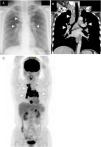A 43-year-old woman was referred to our hospital with bilateral hilar lymphadenopathy on chest radiography. She was examined by enhanced computed tomography scan, and bilateral hilar and mediastinal lymphadenopathy was detected. [18F]-fluorodeoxyglucose (FDG) positron emission tomography (PET) showed a high uptake in the above-mentioned lymphadenopathy, demonstrated by the so-called “lambda (λ) sign” (Fig. 1); therefore, sarcoidosis was suspected. A granuloma in the lymph node specimen and a high CD4/CD8 ratio of BAL were detected on endobronchial ultrasound-guided needle aspiration of the mediastinal lymph node and bronchoalveolar lavage (BAL) fluid examination. Therefore, she was diagnosed with sarcoidosis. As no sarcoid lesions were detected in other organs, such as heart, eyes, and skin, she was followed-up with no treatment.
(A) Chest radiograph showing bilateral hilar lymphadenopathy. (B) Chest computed tomography scan showing the bilateral hilar and mediastinal lymphadenopathy. (C) [18F]-fluorodeoxyglucose positron emission tomography scan showing the so-called “lambda (λ) sign”, indicating a high uptake in the bilateral hilar and mediastinal lymphadenopathy with a prominent right paratracheal region.
The lambda sign means that a bilateral hilar and mediastinal lymphadenopathy with a prominent right paratracheal region on gallium scintigraphy gives the impression of an uptake pattern shaped as a “λ”.1 This sign shows high specificity for sarcoidosis.1 In a recent report, the lambda sign was also observed on an [18F]-FDG PET.2 It has remarkable sensitivity in detection of occult disease sites, hence providing biopsy guidance.3 A typical lambda sign supports the diagnosis of sarcoidosis and reinforces the indication to perform appropriate examinations.



![(A) Chest radiograph showing bilateral hilar lymphadenopathy. (B) Chest computed tomography scan showing the bilateral hilar and mediastinal lymphadenopathy. (C) [18F]-fluorodeoxyglucose positron emission tomography scan showing the so-called “lambda (λ) sign”, indicating a high uptake in the bilateral hilar and mediastinal lymphadenopathy with a prominent right paratracheal region. (A) Chest radiograph showing bilateral hilar lymphadenopathy. (B) Chest computed tomography scan showing the bilateral hilar and mediastinal lymphadenopathy. (C) [18F]-fluorodeoxyglucose positron emission tomography scan showing the so-called “lambda (λ) sign”, indicating a high uptake in the bilateral hilar and mediastinal lymphadenopathy with a prominent right paratracheal region.](https://static.elsevier.es/multimedia/03002896/0000005600000003/v2_202003070709/S030028961930119X/v2_202003070709/en/main.assets/thumbnail/gr1.jpeg?xkr=ue/ImdikoIMrsJoerZ+w98FxLWLw1xoW2PaQDYY7RZU=)








